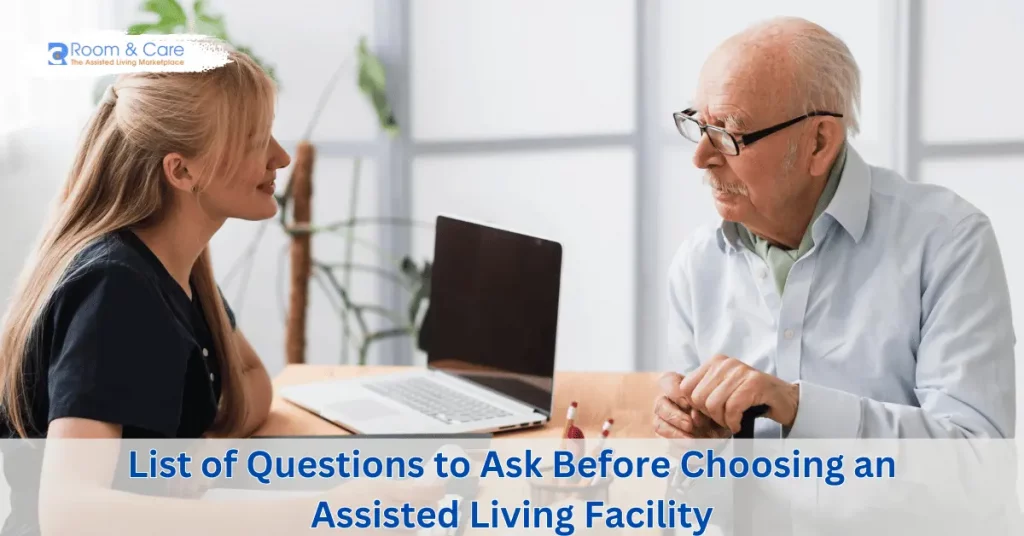

Choosing an assisted living facility is a decision that will impacts the quality of life for your elderly loved one. This choice affects daily living, care, and social interaction over the coming years.
Before visiting any facilities, we’ve compiled a list of detailed questions that address all aspects of life and care within the facility. Some of these are common and obvious, while others may not be too obvious until after you’ve moved in. Armed with these questions, you’ll be better prepared to make an informed decision that aligns with your needs and those of your loved one.
The number of residents in a facility can affect the staff-to-resident ratio, the level of personalized care, and the community environment. Facilities with fewer residents typically provide a more intimate setting, which might be preferable for those seeking a close-knit community.
Ease of access and navigation within the facility are important – especially for residents with mobility issues. Inquire about elevators, ramps, and the layout of common areas. A well-designed facility should prioritize accessibility to all its amenities.
Security in an assisted living facility is multi-faceted, covering everything from secured entrances to emergency response systems. Ask about the types of security employed during the day and night, as well as the procedures for visitor screening.
Personal belongings can help a new living space feel like home. Find out if there are limitations or guidelines for bringing personal furniture.
The availability of different room layouts provides flexibility and choice in how residents want to live. Some might prefer more space, while others may need special accommodations for health reasons.
It’s important that residents feel at home in their new environment. Ask about what changes can be made to the living spaces, such as painting walls or hanging pictures, and whether these modifications require facility approval.
Understanding what is included in the base fee (such as meals, housekeeping, and utilities) will help you assess the total cost of living at the facility.
Many facilities offer additional services like laundry or special care programs, but these may incur extra charges. Clarifying this upfront can help avoid unexpected costs down the line.
Explore the payment options and any financial assistance programs such as Medicare, Medicaid, or veterans’ benefits. Knowing your payment options and any available financial aid can significantly influence your choice.

Understanding how a facility coordinates with external healthcare providers and handles routine and emergency health issues can be a deciding factor.
Having medical services on-site, such as physical therapy, dental care, and regular nurse visits, can provide peace of mind that residents’ health needs will be promptly and efficiently addressed.
Inquire about the protocols for handling medical emergencies, including the availability of on-site healthcare professionals and the proximity to local hospitals.
Dining should be a pleasure, not a chore. Ask to see a sample menu and inquire whether meals are made on-site from fresh ingredients. Discuss how the facility accommodates special dietary needs and preferences.
Nutritional needs can vary greatly from person to person, especially for those with medical conditions that dictate specific diets. A good facility will be flexible and capable of accommodating these needs without issue.
For residents who prefer privacy or are not feeling well enough to dine in a communal setting, the option to have meals in their room can be very important.
Activities should cater to a range of interests and abilities, providing residents with opportunities for physical activity, social interaction, and intellectual stimulation. Ask about the schedule of activities and whether the facility takes resident preferences into account when planning new activities.
Regular outings can keep residents engaged with the wider community and provide a change of scenery. Understanding what types of outings are organized will give you insight into the facility’s commitment to keeping residents active and engaged.
Physical health is closely linked to overall well-being. A facility with a well-equipped gym or regular fitness classes can be a great advantage for residents keen on maintaining their physical health.
Visitor policies are important for residents’ social lives. Facilities might have restrictions on visit times or the number of people who can visit at once, which could impact how often and comfortably residents can see their loved ones.
For many, pets are considered family. If the facility does not allow pets to live on-site, it might permit visits, which can greatly enhance a resident’s quality of life.
Understanding the facility’s rules regarding residents’ movements can indicate how much independence residents are allowed. For some, a strict curfew could be a dealbreaker.

For residents who still drive, being able to keep a car on-site means maintaining a significant amount of independence.
Hidden costs like parking fees can add up. It’s important to clarify what is included in the cost of living at the facility and what is not.
Facilities often provide transportation for shopping trips, medical appointments, and other outings. Knowing the schedule and flexibility of these services can influence your decision.
Smoking policies are important for both smokers and non-smokers in terms of comfort and health considerations.
Alcohol policies vary widely among facilities and can affect the social atmosphere. Understanding these policies will help align expectations and lifestyle choices.
As new forms of smoking become more popular, it’s important to understand how they are handled in communal living environments.
A lower staff-to-resident ratio can ensure more personalized care and quicker responses to residents’ needs.
High staff turnover can affect the quality of care. Facilities with thorough training programs and stable staff are likely to provide better and more consistent care.
Engagement between staff and residents can greatly enhance the community feel of a facility. Examples of staff interaction can give you a sense of the social environment.
After touring various assisted living facilities and gathering information, take some time to reflect on what you’ve learned. Consider how the answers align with your priorities and expectations for care and quality of life.
If this guide has been helpful, consider arranging visits to your top choices. Multiple visits at different times of the day can give you a clearer picture of everyday life and the community dynamics in each facility.
Don’t hesitate to reach out to facility representatives to ask more detailed questions or clarify previous responses. They can provide further insights or introduce you to other family members of residents, which can aid in your final decision.
Armed with thorough insights and answers, you’re now better positioned to make a well-informed decision. Choosing the right assisted living facility is a significant step towards ensuring a fulfilling and supportive living environment for your loved one. For direct connections to the best assisted living facilities near you, visit Room & Care. We provide a direct line to facilities without any referral fees or middlemen, ensuring your choice is facilitated smoothly and transparently.